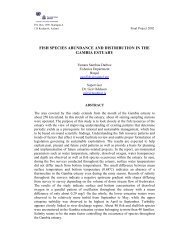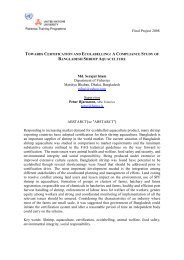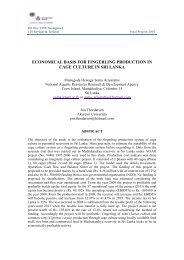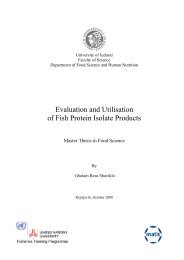QingzhuElectronic nose measurements: Recently, electronic noses have been introduced asalternative rapid techniques to supplement or replace traditional quality controltechniques in the food industry. Electronic nose systems have been designed to be usedfor quality control <strong>of</strong> raw and manufactured products; process, freshness and maturitymonitoring; shelf-life investigation; microbial pathogen detection, etc. (Schaller et al.1998). The electronic nose is promising for application in food industries where rapidmeasurements with no sample preparation are needed to detect microbial spoilage(Olafsdottir et al. 2002). An electronic nose FreshSense based on electrochemical gassensors (CO, SO 2 and NH 3 ) has been used for freshness monitoring <strong>of</strong> various species <strong>of</strong>fish i.e. haddock, capelin, redfish and cod (Olafsdottir and Jonsdottir 2003). Thesensitivity <strong>of</strong> the sensors towards different compounds is different, for example, COsensor has high response to the production <strong>of</strong> alcohols and NH3 can detect the formation<strong>of</strong> amines etc. (Olafsdottir et al. 2002). The responses <strong>of</strong> the electrochemical sensorscorrelate well with classical methods to evaluate freshness and spoilage <strong>of</strong> seafood, i.e.TVB measurements and sensory analysis, for capelin (Olafsdottir et al. 1997a, 2000)herring and fresh roe (Olafsdottir et al. 1997b), and whole or peeled shrimp (Högnadottir,1999).Texture measurements: Some characteristics in shrimp that result in the decline <strong>of</strong>freshness and quality are mainly related to structure, appearance (including colour), odour,water-holding capacity, etc. Texture is a very important property <strong>of</strong> fish product whetherit is raw or cooked. Texture measurement can be used to determine structural changes.The four principal quality factors in food are the appearance (comprising colour, shape,size, gloss), flavour (comprising taste and odour), texture, and nutrition (Malcoim 2002).Texture <strong>of</strong> raw fish can be measured by different methods using mechanical food testingequipment. The main techniques applied for fish are puncture, compression, shear, andtensile stress. Among them, the shearing force and compression methods arerecommended for use with fresh fish (Sigurgisladottir et al. 1999). When the texture <strong>of</strong>raw fish is measured, hardness and springiness are <strong>of</strong>ten the major variables (Botta 1991).Hardness was defined as the maximum force during the first compression cycle (first bite)and has <strong>of</strong>ten been substituted by the term firmness. Its units are N (force). Resilience is ameasurement <strong>of</strong> how the sample recovers from deformation both in terms <strong>of</strong> speed andforce derived. It is taken as the ratio <strong>of</strong> areas from the first probe reversal point to thecrossing <strong>of</strong> the x-axis and the areas produced from the first compression cycle. It is not aparameter from the original Texture Pr<strong>of</strong>ile Analysis (TPA) work but instead has beendeveloped from looking more closely at the elastic recovery <strong>of</strong> the sample. Springiness(originally called elasticity) is related to the height that the food recovers during the timethat elapses between the end <strong>of</strong> the first bite and the start <strong>of</strong> the second bite. There is nounit for this parameter. Cohesiveness is defined as the ratio <strong>of</strong> the positive force areaduring the second compression to that during the first compression. Tensile strength is amanifestation <strong>of</strong> cohesiveness. This parameter is unitless.Figure 1 shows a typical TPA curve generated by the G. F. Texturometer. The height <strong>of</strong>the force peak on the first compression cycle (first bite) was defined as hardness(Malcoim 2002). In Figure 1, A is the beginning <strong>of</strong> the first compression and B is thebeginning <strong>of</strong> the second compression. The ratio <strong>of</strong> the positive force areas under the firstand second compressions (A 2 /A 1 ) defines cohesiveness. The distance that the sampleUNU-Fisheries Training Programme 10
Qingzhurecovered its height during the time that elapsed between the end <strong>of</strong> the first bite and thestart <strong>of</strong> the second bite (BC) was defined as springiness (originally called elasticity).Texture pr<strong>of</strong>ile analysis (TPA) is an objective method <strong>of</strong> sensory analysis pioneered bySzczesniak (1963), who defined the texture parameters first used in this method <strong>of</strong>analysis. Later, Bourne (1978) adapted the Instron to perform TPA by compressingstandard-sized samples <strong>of</strong> food twice. TPA is based on the recognition <strong>of</strong> texture as amulti-parameter attribute. For research purpose, a texture pr<strong>of</strong>ile in terms <strong>of</strong> severalparameters determined on a small homogenous sample is desirable.Figure 1: A typical texture pr<strong>of</strong>ile analysis (TPA) curve ( Malcolm 2002).3 MATERIAL AND METHODS3.1 Raw material and experimental design<strong>Northern</strong> shrimp (<strong>Pandalus</strong> <strong>borealis</strong>), was caught in Arnarfjordur (Westfjords, Iceland)on the 2nd <strong>of</strong> December 2003 and stored in isothermic boxes containing crushed ice,followed by truck transport to the IFL laboratories in Reykjavik two days after catch. Thetemperature <strong>of</strong> shrimp was 4.5 o C and the ice had melted in the boxes holding the shrimpwhen they arrived at the laboratory.The shrimp was randomly divided into 4 groups that were kept under different conditions.The groups were stored in ice at 1.5 o C <strong>of</strong> ambient temperature (room temperature)(ICE/+), in liquid-ice at 1.5 o C (LIQ/+), in liquid-ice at -1.5 o C (LIQ/-) and in salt-waterice at -1.5 o C (S-ICE/-), respectively (Table 2). A thin layer <strong>of</strong> liquid ice and ice were putin the bottom <strong>of</strong> the bin, then a layer <strong>of</strong> shrimp, about 5 cm height, was laid into the binand covered with liquid ice and ice again. This was repeated until the bin was filled up(the layers <strong>of</strong> shrimp kept in each bin were five). All the bins were covered by liquid-ice,ice, or salt-water ice on top and kept at temperature <strong>of</strong> 1.5 o C (ICE/+ and LIQ/+ groups) or-1.5 o C (S-ICE/- and LIQ/- groups). The centre temperature <strong>of</strong> every storage bin wasUNU-Fisheries Training Programme 11
- Page 1 and 2: Final Project 2003Quality Indicator
- Page 3 and 4: QingzhuACKNOWLEDGEMENTS............
- Page 5 and 6: Qingzhu1 INTRODUCTIONThe northern s
- Page 8: Qingzhu2.3 Assessment methods of fr
- Page 13 and 14: Qingzhu3.2 Sensory evaluationA Qual
- Page 15 and 16: Qingzhu3.9 pH measurementpH was mea
- Page 17 and 18: Qingzhu3.13 Data analysisThe data,
- Page 19 and 20: QingzhuThe lowest score was awarded
- Page 21 and 22: QingzhuTVB-N mgN/100g12010080604020
- Page 23 and 24: Qingzhu4.5 Water contentThe effects
- Page 25 and 26: Qingzhu4.7 Water-holding capacity (
- Page 27 and 28: QingzhuSpringiness (N)0.80.70.60.50
- Page 29 and 30: Qingzhu250S-ICE/-200Current (nA) --
- Page 31 and 32: QingzhuTable 4: Correlation (r) bet
- Page 33 and 34: Qingzhu1.0PC2Bi-plotResilience Cohe
- Page 35 and 36: Qingzhuof the main spoilage-causing
- Page 37 and 38: Qingzhu5.6 Correlation analysisThe
- Page 39 and 40: QingzhuNH 3 response of electronic
- Page 41 and 42: QingzhuLIST OF REFERENCESAitken, A.
- Page 43 and 44: Qingzhuof fish in research and indu
- Page 45 and 46: QingzhuAPPENDIXAnalysis of Variance
- Page 47 and 48: QingzhuICE/+4 5 8,564 0,6168125 7,0
- Page 49 and 50: QingzhuTotal (Adjusted) 31 18,5293T
- Page 51 and 52: QingzhuGroup Count Mean Different F
- Page 53 and 54: QingzhuAll 24 0,345750,0572743A: Gr
- Page 55 and 56: QingzhuSource Sum of Mean Prob Powe
- Page 57 and 58: QingzhuS-ICE/-6 8 1,0625 0,12734960
- Page 59 and 60:
QingzhuTerm DF Squares Square F-Rat
- Page 61 and 62:
QingzhuGroup Count Mean Different F
- Page 63:
QingzhuTerm DF Squares Square F-Rat
















